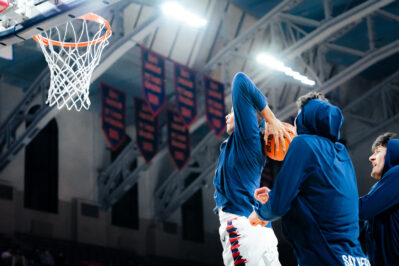Wharton Sports Research Journal
2023 Fall Edition
The papers in this issue include research from students at the University of Pennsylvania as well as high schools and universities across the country, ranging across sports and statistical techniques.
Algorithmic NBA Player Acquisition
Authors: Ryan S. Brill, Justin Hughes, and Nathan Waldbaum
University of Pennsylvania
Optimal Strategy for Defensive Pressure in American Football: Insights from an Expected Sack Model
Author: Tej Seth
University of Michigan
Sidelined: Using Natural Language Processing to Investigate Gender Bias in Basketball Sports Journalism
Author: Nathaniel Yellin
Leffell School
More Than The Sum of Their Parts: Evaluating Defensive Line Construction and Deployment
Authors: Krish Shah, Ezra Troy, Daniel Coale, Sam Pasco, Caleb Cannon
University of Pennsylvania
A Research Study on Formula One: Determining the Effectiveness of Drivers Based on Their Experience
Author: Ignacio Felix-Padilla
University of Pennsylvania
Serving to Win: A Statistical Exploration of Optimal Serves 1 in Beach Volleyball
Author: Zachary Zeng
Southridge School, BC, Canada
2023 Moneyball Academy, Rookie Review
The papers in this issue include research from students who completed our summer high school programs Moneyball Academy and Moneyball Academy Training Camp, as well as senior projects from Professor Adi Wyner’s capstone course at the University of Pennsylvania.
Against All Odds: Leicester City’s Triumphant Journey to Premier League Glory
Authors: Ethan Lu, Nassef Sawiris, Dustin Liu, Matteo Musicco
The Drafting Dynasty: Which NBA Franchise Dominates the Draft?
Authors: Vik Dandapani, Pranav Batra, Ben Wolf, Alex Min, and Juju Zhao
Optimal Rest Days for Pitchers: Maximizing Performance and Wins
Authors: Blake Zilberman, Philip Sherr, Lyev Pitram, Marc Sutton
Are “Surprise Teams” in the MLB in 2023 More Surprising?
Authors: Chad Federico, Kotaro Nagano, Alejandro Wick


2023 Fall Edition
Algorithmic NBA Player Acquisition
Ryan S. Brill, Justin Hughes, and Nathan Waldbaum
Player acquisition is one of the fundamental problems of basketball analytics. An analyst may be tempted to recommend simply acquiring the best available player, where best is defined by an all-encompassing skill metric. How a player fits with his teammates, however, is also important in determining the effectiveness of a lineup. Thus in this paper we model the effectiveness of a lineup as an interacting function of the offensive skill, defensive skill, and player archetype of all ten players on the court. We find that fit is indeed just as essential as skill in crafting a lineup.
Optimal Strategy for Defensive Pressure in American Football: Insights from an Expected Sack Model
Tej Seth
The impact of a defender getting to the quarterback and recording a sack is a critical outcome in American football. However, limited research has been conducted on the positioning of defenders that could potentially increase their chance of success. In this study, we utilize a combination of Pro Football Focus charting data and NFL Next Gen Stats tracking data to create the probability of a defender recording a sack based on their X and Y coordinate alignment, listed position, offensive and defensive formations and game situation information.
Sidelined: Using Natural Language Processing to Investigate Gender Bias in Basketball Sports Journalism
Nathaniel Yellin
In this journal article, I investigate gender bias in sports journalism, focusing on ESPN.com coverage of National Collegiate Athletic Association (NCAA) basketball. With the programming language R and using natural language processing (NLP) techniques, I analyze articles on ESPN.com to create the R Shiny application Sidelined. Performing sentiment analysis on the adjectives used to describe NCAA athletes, I reveal that there is a notable qualitative difference in how female NCAA athletes are covered, especially those who play the center position. Sidelined is innovative and can be explored to investigate, with data visualizations and word clouds, the extent to which gender bias exists on ESPN.com at the specific team or player level.
More Than The Sum of Their Parts: Evaluating Defensive Line Construction and Deployment
Krish Shah, Ezra Troy, Daniel Coale, Sam Pasco, Caleb Cannon
A productive defensive line is a key part of a successful NFL (National Football League) team. With salary cap and roster constraints, acquiring and deploying players to create a productive defensive line is a difficult task of significant interest to NFL front offices. While most attempts to value defensive line
production focus on individual attribution, we propose valuing a defensive line as an entire unit, aiming to capture the surplus value generated when different types of players work together on the field. After formulating this methodology, we examine potential applications in both player selection and deployment.
A Research Study on Formula One: Determining the Effectiveness of Drivers Based on Their Experience
Ignacio Felix-Padilla
As of August 2020, there were eight Formula One drivers without a firm contract to race in the 2020-2021 season, out of only twenty driver seats in what is the highest circuit of car racing worldwide. Every year, teams have to decide to sign a driver that is already racing in, or that was recently racing in Formula One, or bring up a new driver either out of Formula Two (the racing league directly one level below Formula One) or from another racing league (Balfour, 2020). Teams had to make a decision: go for the experience or gamble for young potential. The null hypothesis to be proven or disproven through this research is that a rookie driver is a more efficient decision for teams versus hiring an experienced veteran.
Serving to Win: A Statistical Exploration of Optimal Serves 1 in Beach Volleyball
Zachary Zeng
Serving is the only part of a game of volleyball that is the same every time. Despite this, 8 serving strategy and philosophy vary greatly. Teams who use the analytically optimal serve 9 the most can gain a distinct advantage. In identifying the optimal serve, conclusions about 10 best serve type, best serve location, and relationships between errors and effectiveness can 11 be understood. These results will guide training and in-game beach and indoor volleyball serving strategies.


2023 Moneyball Academy, Rookie Review
Against All Odds: Leicester City's Triumphant Journey to Premier League Glory
Ethan Lu, Nassef Sawiris, Dustin Liu, Matteo Musicco
Leicester City Football Club achieved the unimaginable by defying all odds and capturing their first-ever Premier League title. All of the news articles that were published about this event only stated the odds and did not provide any statistics to explain their numbers.
This phenomenon was never explained with reasons that could convince us so we are asking the following question: How did Leicester City Football Club win the English Premier League contrary to all expectations?
![]()
The Drafting Dynasty: Which NBA Franchise Dominates the Draft?
Vik Dandapani, Pranav Batra, Ben Wolf, Alex Min, Juju Zhao
This study goes in-depth into four decades’ worth of NBA draft data (1981-2021) to understand if particular NBA teams have excelled in the draft over time or if their success was fleeting. To determine the caliber of draft selections, we introduce a new metric, the “JOKIC” (Judging Outstanding Knowledge In (Draft) Choice).
![]()
Optimal Rest Days for Pitchers: Maximizing Performance and Wins
Blake Zilberman, Philip Sherr, Lyev Pitram, Marc Sutton
Five-man rotations have been the regular season norm for decades. This long-standing standard may lead to a mental bias, similar to the aversion to underhanded free throws in basketball. Are teams following the norm because it is the norm, or because it is correct?
![]()
Are “Surprise Teams” in the MLB in 2023 More Surprising?
Chad Federico, Kotaro Nagano, and Alejandro Wick
Halfway through the 20 23 season, many teams are playing much better or worse than expected considering their payrolls. Injuries have also led to unexpected team performances on the field. Surprise teams usually have a Pythagorean Winning Percentage that differs from their actual win percentage. Luck/chance always plays a factor in determining “surprise teams,” but we investigate whether the extent to which we are seeing surprise teams in 2023 is significantly greater than recent years.
![]()


